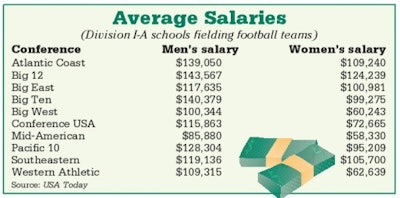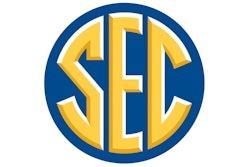The EEOC's new guidelines augur a windfall for coaches of women's teams

On October 31, 1997, the United States Equal Employment Opportunity Commission (EEOC) released Enforcement Guidance on Sex Discrimination in the Compensation of Sport Coaches in Educational Institutions. Donna Lopiano, executive director of the Women's Sports Foundation, calls the new guidelines "the equivalent of what Title IX regulations meant for women's athletics. This interprets how our nation's employment laws will apply to athletic coaches." According to Lopiano, the guidelines offer "some real ammunition" to plaintiff attorneys - and as such, will have a significant impact on the administration of collegiate and high school athletic programs.
The EEOC is a federally funded independent commission established by Title VII of the Civil Rights Act of 1964. The EEOC enforces the principal federal statutes prohibiting employment discrimination, including:
• Title VII of the Civil Rights Act of 1964, as amended, which prohibits employment discrimination on the basis of race, color, religion, sex or national origin;
• The Age Discrimination in Employment Act of 1967 (ADEA), as amended, which prohibits employment discrimination against individuals 40 years of age and older;
• The Equal Pay Act of 1963 (EPA), which prohibits discrimination on the basis of gender in compensation for substantially similar work under similar conditions;
• Title I of the Americans with Disabilities Act of 1990 (ADA), which prohibits employment discrimination on the basis of disability in both the public and private sector, excluding the federal government; and
• Section 501 of the Rehabilitation Act of 1973, as amended, which prohibits employment discrimination against federal employees with disabilities.
The new guidelines set forth EEOC's position on the application of the Equal Pay Act and Title VII to sex discrimination in payment of men's and women's sports coaches in educational institutions. The guidelines indicate that compensation of men's and women's coaches does not have to be the same; however, any compensation disparity must be proved by the institution and cannot be based on a coach's sex.
According to the EEOC, guidelines were made necessary by the large disparity in pay between coaches of men's and women's collegiate teams. [See table.] The EEOC believes that case law does not provide sufficient guidance, due to the uniqueness of cases and "incomplete analyses of the law." Furthermore, the commission adds, "There are many misconceptions which are often raised in considering these pay disparities." One misconception is that men's basketball and football are profitable, the EEOC argues: While both are revenue-generating sports, they are for the most part not profitable.
In its legal analysis of the Equal Pay Act and Title VII of the Civil Rights Act of 1964, the EEOC adds two general points that are extremely important:
• "The jobs should be analyzed functionally, i.e., in terms of what the actual job requirements are, and not simply with regard to the particular physical skills which are being taught or coached." This allows a comparison between coaches of the same sport as well as coaches of different sports (the EEOC refers to comparison coaches as "comparators").
• "From analyzing the conditions of employment, the commission will apply the Title IX principle that the support provided to particular teams at an educational institution (and thus to their coaches) may differ so long as the treatment of the men's and women's programs overall is non-discriminatory." This may impact the defense oftentimes successfully used by institutions that pay differential is based on market-related conditions.
Had these interpretations (and the guidelines as a whole) been in place earlier, results in previous pay equity cases decided in favor of institutions - see Bartges v. UNC-Charlotte (908 F. Supp. 1312) and Deli v. University of Minnesota (863 F. Supp. 958) - may have been changed. At the very least, the burden of proof to win these cases would have been greater for the institutions.
While the commission notes that the burdens of proof and defenses in Title VII cases are similar to Equal Pay Act cases for unequal pay in equal work cases, it is important to note that Title VII covers situations where there is not "equal work." In other words, even where there is unequal work, wage discrimination may exist.
The first step in an Equal Pay Act claim is to select another coach at the same institution who is of the opposite sex and has earned higher wages for a substantially equal job. (More than one comparator can be selected.) To determine if, in fact, the jobs are substantially equal, the criteria of skills, effort, responsibility and working conditions are then analyzed:
• The skills of the coach and comparator must be examined, considering such factors as "experience, training, education and ability." The skills must relate to the performance of the job, which in this case is coaching, and not something tangential to the job such as a radio show.
• In considering equal effort, the EEOC looks to duties and responsibilities of coaching, noting that most high school and college coaches are required to:
1. teach/train 2. counsel/advise student-athletes 3. perform general program management 4. perform budget management 5. raise funds 6. perform public relations tasks 7. recruit student-athletes (at the college level).
Some coaching positions require other duties such as management of staff and event management. The guidelines state that the EEOC will not limit its analysis to coaches of like sports.
• Responsibility, according to the commission, "is concerned with the degree of accountability required in the performance of the job, with emphasis on the importance of the job obligation." The EEOC emphasizes that the jobs need not be identical. In other words, the male and female coaches may have different job responsibilities, such as one having scheduling responsibilities and the other having budgetary responsibilities, and that this may constitute equal responsibility.
• Similar working conditions, the EEOC believes, is not a factor since most coaches work under similar working conditions.
Once the plaintiff establishes a comparator and demonstrates that the jobs are substantially equal and the pay discriminatory, the burden shifts to the employer. The employer can justify the pay differential (referred to as an affirmative defense) if it is based on a seniority system, a merit system, a system that measures earnings by quantity and quality of production, or any other factor other than the sex of the coaches. The EEOC guidelines do not discuss seniority systems and merit systems, since both are established areas of labor relations, and dismisses the production measurement as not applicable to coaches. Instead, the guidelines focus on the fourth defense, "factors other than the sex of the coaches." These, the EEOC points out, have been raised in previous litigation:
1. Revenue as a factor other than sex. The EEOC will accept this defense as long as the institution has not provided discriminatorily reduced support to a female coach to produce revenue for her team.
2. The marketplace as a factor other than sex. The market-rate defense, which has been rejected by the courts and the EEOC, is based on the employer's assumption that "women are available for employment at lower rates of pay due to 'market' factors such as the principle of 'supply and demand.' " The "marketplace value" defense is based on the value of a particular individual's job-related characteristics, and is a valid defense as long as the employer can demonstrate that lower pay for jobs done by women is not based on sex.
3. Reliance on the employee's prior salary as a factor other than sex. Defending a pay differential using an employee's prior salary to justify a high salary leads to an assessment of whether the employer:
• consulted with the employee's previous employer to determine the basis for the employee's starting and final salaries
• determined that the prior salary was an accurate indication of the employee's abilities based on education, experience or other relevant factors
• considered the prior salary, but did not rely solely on it for setting the employee's current salary
• bargained with women as well as men over salaries.
4. Sex of the athletes as a factor other than sex. The sex of athletes being coached may be used as a justification for a pay disparity. However, the employer would have to prove that there has been equal opportunity for both men and women to obtain those positions.
5. Experience, education and ability as a factor other than sex. "Superior experiences, education and ability may justify pay disparities," the EEOC says, "if distinctions based on these criteria are not gender-based."
6. More duties. This is a valid defense to justify the payment of higher wages if the wages are related to the extra work and the duties are not distributed in a discriminatory manner.
The courts will be asked to determine the legal enforceability of these guidelines. While the guidelines do not carry the weight of law, guidelines are generally deferred to if they are determined to be consistent with laws and regulations already in place. Assuming the guidelines are deemed to be consistent with existing laws, here are a few observations and comments:
1. The guidelines have the potential to significantly impact the current pay scale of coaches, especially the salaries of coaches of women's teams.
2. The guidelines will have the impact of decreasing the wage differentials between coaches of men's and women's teams in the same sport.
3. Since they may allow comparators of different sports, the guidelines may have the impact of decreasing the wage differentials of coaches in different sports, both for men's and women's teams.
4. The EEOC may be called upon to clarify and/or further elaborate on its guidelines.
5. The courts will be asked to determine and clarify many issues, and answer such questions as:
• In evaluating the defense that one coach has more education, what advanced degrees will be considered as appropriate, and how much of a pay differential does the advanced degree justify?
• What job duties constitute equal responsibility?
• How are different experiences weighed. Is five years of Division III head coaching experience equivalent to 10 years of Division I assistant coaching experience?
• Does the fact that men's team coaches have many more professional sports coaching opportunities impact market-value analysis?
6. The various defenses allowed in the guidelines will be more difficult for institutions to use successfully. Use of several of the defenses is contingent upon a finding of non-discrimination in other aspects of the athletic department's operation.
7. The cost of running an athletic department will increase, since the cost of paying coaches will probably increase, leading to pressure on institutions to generate greater revenues. While equity could be achieved by reducing men's team coaches' salaries, such a scenario is highly unlikely, at least in the short term. In the long term, financial and legal pressure to reduce men's coaching salaries could cause institutions to hire men's replacement coaches at lower salaries.
8. The EEOC guidelines further link salaries within an athletic department. Therefore, any single contract must be negotiated with an eye on the impact it may have on other contracts.
9. While football coaches would not seem to be affected by these guidelines, it will be interesting to see whether a plaintiff can successfully use one as a comparator. The EEOC dismisses the notion that a head football coach could be used as a comparator for a head women's volleyball coach, but it is certainly possible that assistant coaches in other sports might try to use assistant football coaches (position coaches, not offensive and defensive coordinators) as comparators.
10. Since the guidelines mention that coaching job openings should be available to both men and women, more women may be applying for jobs to coach men's teams.
11. The use of more detailed and objective criteria in coaching salaries and the use of comparators moves intercollegiate athletics closer to the salary-arbitration systems used in Major League Baseball and the National Hockey League.
For these and other reasons that subsequent case law will make clear, athletic administrators would be well-advised to review the new EEOC guidelines carefully.




































